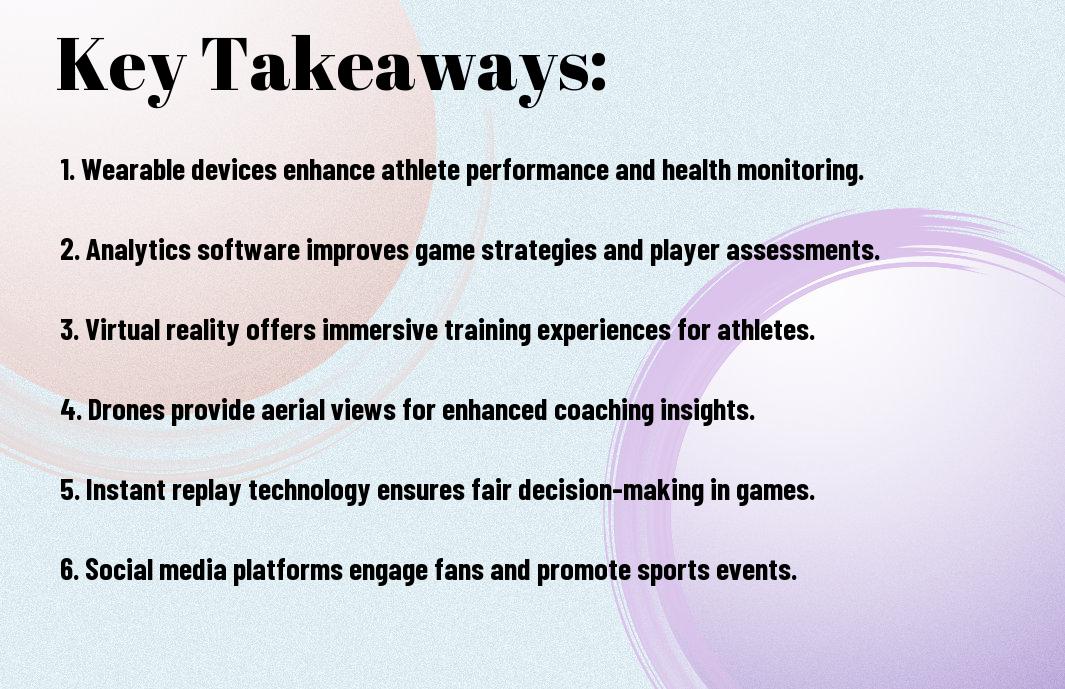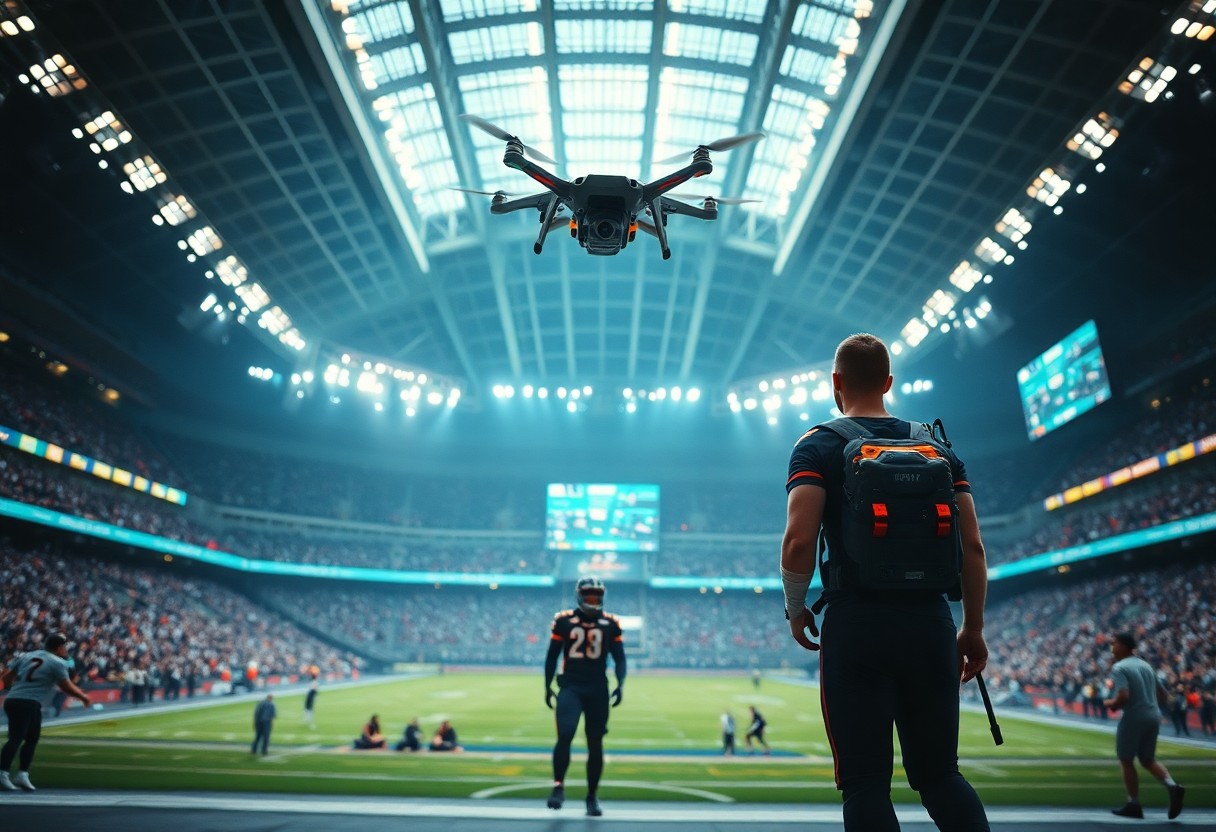Most people may not realize how deeply technology has transformed the landscape of sports over the years. From wearable devices that monitor athlete performance to advanced analytics that enhance game strategies, you’ll see how innovations have shaped not only how athletes train but also how games are played and experienced by fans. In this post, you’ll explore the journey of sports technology, highlighting key advancements and their impact on both amateur and professional levels.
Key Takeaways:
- Performance Analysis: Advanced analytics tools have transformed how athletes and teams assess performance metrics, leading to enhanced training regimens.
- Wearable Technology: The integration of wearables like fitness trackers and smart apparel has provided real-time physiological data, improving injury prevention and recovery.
- Virtual Reality: VR technology is being used for immersive training experiences, allowing athletes to simulate game scenarios without physical risk.
- Fan Engagement: Digital platforms and augmented reality are reshaping how fans interact with sports, enhancing experiences and creating new revenue streams.
- Broadcast Innovations: Cutting-edge video technologies, including 4K resolution and instant replay systems, have elevated the viewing experience for fans worldwide.
The Early Days of Sports Technology
Your understanding of sports technology begins with its humble origins, where athletes relied on basic tools to enhance their performance. Initially, technology in sports was about simple equipment, such as wooden bats, leather balls, and hand-sewn jerseys that improved gameplay, albeit marginally. As time passed, the integration of simple yet effective innovations laid the groundwork for the complex systems we see in sports today.
Invention of Equipment
Sports have always been a mix of skill and tools. From the earliest days, equipment like the javelin and the discus was designed to help athletes excel in their respective fields. These innovations not only improved efficiency but also allowed for new sports disciplines to emerge, showcasing the importance of equipment as a factor in athletic performance.
Introduction of Timing Devices
Above all, timing devices revolutionized how you perceive competition and performance in sports. Traditionally, races were timed by hand, leading to inaccuracies. However, the introduction of timing mechanisms began to standardize results, adding a new level of professionalism to athletics and other competitive sports.
Devices such as stopwatches and mechanical timers played a significant role in this evolution. With the introduction of electronic timing, accuracy improved dramatically, allowing athletes and coaches to analyze performance with precision. This advancement not only provided fairer outcomes in competitions but also opened avenues for data analytics, which athletes now use to tailor their training regimens and strategies effectively.

The Age of Electronics
There’s no denying that the advent of electronics transformed the world of sports. With the integration of advanced technology, the way we play, watch, and analyze sports has changed dramatically. From the introduction of electric scoreboards to the use of instant replay, electronic innovations have enhanced the experience for athletes and fans alike, paving the way for more engaging and efficient sporting events.
Scoreboards and Broadcasting
Any sports fan today can appreciate the impact of electronic scoreboards and broadcasting technology. Gone are the days of manual scorekeeping; now, you can effortlessly follow the action on high-definition screens with real-time updates. Broadcasting innovations have made it possible for you to watch your favorite teams from anywhere in the world, bringing unparalleled access to live sports.
Telemetry and Data Collection
The integration of telemetry and data collection into sports has changed how you view performance and strategy. Tracking necessary metrics such as speed, heart rate, and movement patterns has become standard practice across various sports, leveraging technology to enhance both training and competition.
Understanding the significance of telemetry in sports allows you to grasp how data informs decisions. Coaches and athletes analyze this vast amount of information to identify strengths, weaknesses, and patterns, which can dramatically influence outcomes. For you, the fan, this means deeper insights into athlete performances and strategies, providing a richer viewing experience. As technology continues to evolve, the potential for even more sophisticated data analytics looks promising for the future of sports.
Wearable Technology in Sports
Despite the long-standing tradition of sports, the integration of wearable technology has revolutionized how athletes train and compete. These innovations allow you to gather real-time data about your performance, enhancing both training regimens and injury prevention strategies. As devices become more sophisticated, your potential to optimize your athletic abilities increases dramatically, paving the way for a new era in sports competition.
Fitness Trackers and Smartwatches
Along with the rise of health consciousness, fitness trackers and smartwatches have surged in popularity, enabling you to monitor your physical activity with ease. These devices track various metrics—such as heart rate, distance, and calories burned—allowing you to set measurable goals and stay motivated on your fitness journey.
Performance Analysis Devices
The advancement in performance analysis devices provides you with sophisticated tools to assess your athletic skills. These cutting-edge technologies utilize metrics like speed, agility, and technique to give you a comprehensive view of your performance, ultimately helping to refine your approach to training.
Indeed, performance analysis devices employ a blend of sensors and software analytics that allow you to review and enhance your techniques physically and tactically. From motion capture systems to pressure-sensitive insoles, these tools provide detailed insights into your movements and biometrics. Such detailed data empowers you to make informed decisions and tailored adjustments to your training, which can significantly elevate your game and lead to improved results on the field or court.
Advanced Analytics and Data Science
Many industries, including sports, have embraced advanced analytics and data science to enhance performance and decision-making. By leveraging complex algorithms and vast datasets, teams can refine strategies and inform training regimens. Here are some key elements of this transformation:
- Player Tracking Technologies
- Wearable Devices
- Game Situation Analysis
- Fan Engagement Metrics
| Area | Effect |
|---|---|
| Team Performance | Improved strategy development |
| Player Development | Customized training programs |
| Injury Prevention | Data-driven health monitoring |
Big Data in Sports
After collecting vast amounts of data from games, practices, and player interactions, sports organizations now employ big data to analyze trends and improve outcomes. This data encompasses everything from player statistics to fan behavior, enabling you to gain insights for optimizing team performance and enhancing your experience as a fan. Utilizing advanced analytics can foster a nuanced understanding of the game, allowing teams to make informed decisions swiftly.
Predictive Analytics for Performance
Across the sports landscape, predictive analytics is reshaping the way you view performance assessments. By analyzing historical data patterns, teams can foresee potential outcomes and devise strategies tailored for success in future matches.
Sports organizations are leveraging predictive analytics to enhance player performance and optimize training regimens. By assessing past behaviors and outcomes, you can identify which factors are most likely to contribute to a player’s success on the field. This data-driven approach allows coaches to personalize training, making adjustments that significantly improve your players’ chances of excelling in competitive situations. Accurate modeling can transform how teams strategize, enabling them to predict opponents’ tactics and adjust their play style accordingly.
Virtual and Augmented Reality in Training
Not only has technology revolutionized how you train, but virtual and augmented reality (VR/AR) has taken it to another level. By immersing yourself in realistic simulation environments, you can hone your skills without the limitations of traditional training methods. Coaches and athletes alike are discovering that VR/AR offers personalized training experiences that enhance performance and game strategy understanding.
Immersive Training Environments
The integration of VR technology in sports training creates immersive environments where you can practice in realistic settings. This technology allows you to visualize game scenarios, enhancing your decision-making skills under pressure. Your training sessions can become more engaging and effective, leading to improved athletic performance when it matters most.
Fan Engagement through VR/AR
At the forefront of enhancing fan experiences, virtual and augmented reality are transforming how you interact with sports. With VR experiences, you can step into the shoes of your favorite players or enjoy unparalleled views of the game from your home. AR applications enrich your in-stadium experience by providing live statistics and highlights, ensuring that you stay connected to the action in innovative ways.
And as the technology evolves, the possibilities for fan engagement expand significantly. You’re no longer just a spectator, but an active participant in the sporting experience. Sporting events can be enhanced with augmented experiences, allowing you to access exclusive content, immersive replays, and even virtual meet-and-greets with athletes. This level of interactivity not only deepens your connection to the sport but also creates lasting memories that go beyond the game itself.

The Future of Sports Technology
Keep an eye on the advancements that will shape the future of sports technology. As you explore innovations, be sure to check out The Impact of Technology on Sports Performance – Yellowbrick for insights on how these developments will enhance athletic performance, fan engagement, and coaching methodologies.
Innovations on the Horizon
About the future of sports technology, you can expect remarkable innovations such as AI-driven analytics, augmented reality training, and advanced wearable devices. These tools will not only enhance player performance but also transform how you experience sports as a fan.
Ethical Considerations and Regulations
Between the excitement of new technologies lies the need to address ethical considerations and regulations. As advancements reshape your experience in sports, it’s crucial to understand issues surrounding data privacy, fairness, and the integrity of competitions.
But as technology evolves, governing bodies will face the challenge of implementing regulations that protect the rights of athletes while promoting innovation. You should be aware of how these regulations can impact player data collection, performance-enhancing technologies, and the overall landscape of sports ethics. Balancing progress with responsibility will be key to maintaining the spirit of competition in your favorite sports.
Conclusion
Now that you have explored the evolution of sports technology, you can appreciate how advancements have transformed athletic performance, fan engagement, and overall sports experiences. From wearable devices enhancing training to virtual reality simulations revolutionizing coaching methods, these innovations continue to shape the future of sports. As you follow these advancements, you’ll find new ways to enhance your performance and enjoyment of your favorite activities, ensuring that you stay at the forefront of this exciting evolution.
Q: How has data analytics transformed sports strategy and performance?
A: Data analytics has significantly impacted how teams approach strategy and performance assessment in sports. With advancements in technology, teams now collect vast amounts of data regarding player performance, team dynamics, and opponent strategies. Through tools like wearable devices, GPS trackers, and video analysis software, coaches can analyze athletes’ movements and strategies in real-time. This information helps in making informed decisions about training regimes, game plans, and player health management, ultimately enhancing overall team performance and competitiveness.
Q: What role does virtual reality play in training athletes?
A: Virtual reality (VR) has emerged as a game-changing tool in athlete training across various sports. By simulating real-life game scenarios, VR allows athletes to immerse themselves in practice environments without the physical strain of actual gameplay. This technology facilitates skill acquisition, cognitive decision-making, and situational awareness by enabling athletes to repeatedly experience challenging situations. As a result, athletes can refine their skills, improve reaction times, and experience various game conditions that may not be feasible during traditional training sessions.
Q: How is equipment technology evolving in sports?
A: Equipment technology has seen remarkable innovations, leading to enhancements in athlete performance and safety. From high-tech fabrics in sports apparel that wick away moisture and enhance breathability to advanced materials in shoes and gear that provide better support and protection, these developments are substantial. Technologies like 3D printing are also reshaping the production of custom-fitted equipment. Additionally, improvements in materials science, like lighter yet stronger composites in sports gear, ensure athletes have the best tools to perform at their highest level while minimizing the risk of injury.


